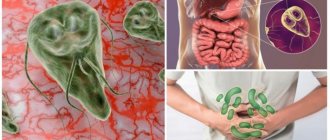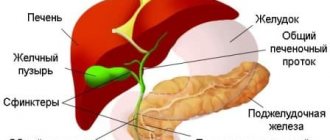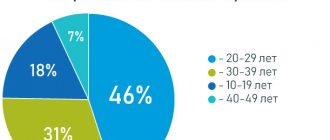Reading time - 7 minutes.
Adnexitis (salpingoophoritis) is an inflammation of the fallopian tubes and ovaries. In the structure of gynecological pathologies, inflammatory diseases of the pelvic organs occupy first place. According to statistics, about 60-65% of women of early reproductive age experience symptoms of adnexitis at least once in their lives.
In modern conditions, the number of sluggish and chronic forms of the disease with erased signs is increasing. This is due to the widespread use of antibiotics, which lead to the emergence of resistant microflora, and to the prevalence of hidden sexually transmitted infections. Scanty symptoms lead to inadequate and untimely treatment. Complications develop. Treatment of adnexitis in such cases is difficult and lengthy. The woman is hospitalized and the full arsenal of means available in medicine is used to maintain health and rehabilitation. It is not always possible to completely stop inflammation. Adnexitis recurs, becomes chronic and leads to irreversible changes in the internal genital organs.
Gynecologists at the MedEx clinic in Moscow urge patients to be attentive to their health. In the initial stage, adnexitis of the appendages responds well to treatment and is eliminated without consequences. The prognosis is favorable. Make an appointment with your doctor when the first symptoms of the disease appear.
How does adnexitis develop?
The cause of inflammation is infection. The pathological process develops when infected with chlamydia, gonococcus, mycoplasma, trichomonas. In rare cases, with a significant decrease in immunity, adnexitis can be caused by bacteria from the natural microflora of the genital organs.
Infection occurs along an ascending route:
- Active infection: chlamydia and gonococci enter the genitals along with sperm, pathogens of their own microflora rise from the cervical canal;
- Passive transport: spread of bacteria from the primary focus of inflammation to the uterine appendages with lymph flow (the picture is typical for tuberculosis of the female genital organs).
Important!
Ovarian adnexitis can occur due to endometrial injury. Inflammation develops after a long stay of the intrauterine device in the uterine cavity or after gynecological manipulations. The contact path of inflammation is also described, when the ovary is in direct contact with the source of inflammation, for example, in colitis, cystitis, appendicitis.
Causes of occurrence and mechanism of development
The causative agent of adnexitis is microorganisms that cause urogenital infections.
They can enter a woman’s body through contact, ascending, descending, hematogenous, and lymphogenous routes. In patients with adnexitis, blood and urine tests reveal the following pathogens:
- staphylococci;
- streptococci;
- enterococci;
- gonococci;
- Trichomonas;
- chlamydia;
- ureaplasma;
- fungi;
- Mycobacterium tuberculosis;
- anaerobic bacteria;
- viruses (CMV, HSV, HPV, etc.);
- coli.
Depending on the pathogen, the inflammatory process during adnexitis can be right- or left-sided, as well as bilateral - with simultaneous involvement of the uterine appendages in the process. The unilateral form is typical if the cause of the disease is Escherichia coli, staphylococcus or streptococcus; with bilateral adnexitis, the causative agent is most often gonococcus or Mycobacterium tuberculosis (Koch bacillus, or tuberculosis bacillus).
As a rule, adnexitis is accompanied by a weakening of the immune system due to an infectious disease, psychogenic stress, and hormonal imbalance. Factors contributing to inflammation of the uterine appendages can be violations of a healthy lifestyle: promiscuous, unprotected sexual intercourse, neglect of hygiene procedures, etc.
Due to the possibility of severe complications developing with adnexitis, adequate treatment is necessary when the first symptoms of the disease appear, the leading of which is pain.
Types of salpingoophoritis
According to the clinical course, adnexitis occurs:
- Spicy. The symptoms are pronounced. Acute adnexitis lasts up to 30 days. In every third case, the inflammation goes away completely, the remaining patients develop a chronic form;
- Subacute. Symptoms gradually disappear. Subacute adnexitis can still be cured if you immediately consult a doctor;
- Chronic. A disease with an unknown duration of development that exceeds 30 days. With chronic adnexitis, long-term remissions can be achieved, but the inflammation will recur.
Types of pathology by localization:
- Bilateral adnexitis. Inflammation spreads to the left and right appendages, affecting both ovaries;
- Right-sided adnexitis. The pathology is localized on the right. Symptoms appear on one side only;
- Left-sided adnexitis. The source of inflammation is located on the left side, affecting one tube and the ovary.
According to the nature of the disease, it can be:
- catarrhal;
- purulent.
Operations for chronic adnexitis
The chronic form of adnexitis without treatment is accompanied by suppuration. With advanced abscesses of the appendages, pills and injections will no longer help, so gynecologists recommend surgery. During intervention, the abscesses are opened and washed.
Now such operations are performed in a minimally invasive way - through laparoscopy. The essence of the technique is the possibility of performing all abdominal manipulations through several tiny holes in the anterior abdominal wall. Mini-instruments and video equipment are inserted into these punctures, making laparoscopy one of the safest surgical techniques.
Signs of adnexitis
The clinical picture is quite specific;
- Pain in the lower abdomen is usually sharp. Pelvic pain with adnexitis can be left- or right-sided and can radiate to the rectum, thigh, or lower back;
- Temperature rises to 38 °C. Some patients experience fever and chills;
- Signs of intoxication. The woman feels nausea, weakness, and her stomach is swollen;
- Dysuric phenomena. Urination becomes more frequent, and with widespread infection, false urges are possible.
The symptoms of chronic adnexitis are similar, but less pronounced. Periods of complete remission are followed by exacerbations. As it progresses, sexual dysfunction and menstrual irregularities are observed.
Expert advice
With chronic ovarian adnexitis, the symptoms can be so weakened that the woman endures it and does not see a doctor. Some patients take medications on their own during exacerbations to alleviate their condition. This is a big mistake. You will be able to suppress the symptoms, but the inflammatory process will continue to develop. The longer the infection remains in the genital tract, the more severe the consequences.
If you know about your problem, if pain in the appendage area appears every time after hypothermia, acute respiratory viral infection or stress, consult a doctor. Exacerbation of chronic adnexitis should be treated by an experienced gynecologist. Only under medical supervision can stable remission be achieved and inflammation stopped.
Bani Odekh Elena Yurievna
Obstetrician-gynecologist, gynecologist-endocrinologist, ultrasound diagnostics doctor, Candidate of Medical Sciences Experience 23 years
Possible consequences
In addition to purulent complications, adnexitis is fraught with the following unpleasant consequences for a woman:
- ectopic pregnancy;
- spontaneous miscarriage;
- secondary infertility.
Their occurrence is due to the fact that inflammation sooner or later leads to the formation of adhesions around the ovaries and tubes, infiltrates (tissue compaction), and the formation of sclerotic processes in the tubes, which leads to their obstruction. Therefore, a woman’s ability to become a mother depends on the timely diagnosis of subacute adnexitis or its chronic form.
Even unexpressed, seemingly harmless chronic adnexitis can provoke secondary inflammation of neighboring organs - the intestines, gallbladder and bladder.
Diagnosis of adnexitis
First of all, a woman should come to see a doctor. A standard gynecological examination will already suggest a diagnosis and outline treatment tactics. When palpating the internal genital organs, the doctor determines pain in the area of the uterine appendages, the nature of the discharge, which, when inflamed, becomes serous-purulent in nature.
Additional studies are needed for an accurate diagnosis:
- General blood analysis. The main indicators and leukocyte formula are determined. With adnexitis, tests show leukocytosis, increased ESR, a shift towards band leukocytes, positive C-reactive protein;
- PCR study. The analysis is prescribed to determine the causative agent of the disease;
- Bacteriological culture. The study helps to select the most effective antibiotic to treat inflammation;
- Gynecological smear. Material is collected directly during the inspection. The clinic of adnexitis is accompanied by an increase in the number of leukocytes, identification of cocci, trichomonas, gonococci or spores of a yeast-like fungus;
- Laparoscopy, laparotomy or puncture of the posterior vaginal vault. The procedure is prescribed for microbiological examination of the contents of the appendages and abdominal cavity in cases where the pathogen cannot be determined by other methods. During laparoscopy, the doctor assesses the degree of swelling and hyperemia of the tubes, the localization of exudate, and excises tissue for analysis;
- Transvaginal ultrasound of the uterus and appendages. The sonogram determines acoustic signs of the presence of free fluid in the fallopian tube - inflammatory exudate. In chronic salpingoophoritis, adhesions and altered appendages are visible.
Exacerbation of adnexitis requires differential diagnosis with ectopic pregnancy, torsion of the ovarian neoplasm, acute salpingitis, endometritis and appendicitis.
Complications of inflammation of the appendages
Adnexitis is dangerous due to complications, the worst of which for women are:
- A tubo-ovarian abscess is a tumor, the rupture of which causes the deadly disease pelvioperitonitis, a purulent lesion of the pelvic peritoneum.
- Infertility caused by adhesions or hydrosalpinx - accumulation of fluid in the tubal lumen;
- Ectopic pregnancy due to crypts (depressions) in the fallopian tubes;
- Dyspareunia (pain during sexual intercourse) caused by low-grade inflammation and other reasons.
Treatment of adnexitis in women
Hospitalization is recommended for patients with acute bilateral adnexitis. In a hospital setting, the doctor will be able to observe the dynamics of the disease and promptly adjust prescriptions.
Conservative therapy
Treatment of inflammation is based on the use of antibiotics. The medicine is selected taking into account the type of pathogen. For example, when gonococci are detected, cephalosporins are prescribed, chlamydia requires the prescription of macrolides or tetracyclines, and metronidazole is effective against anaerobic flora. For outpatient treatment, antibiotics are prescribed in tablet form.
Complex therapy also includes drugs from the following groups:
- non-steroidal anti-inflammatory drugs;
- sedatives;
- infusion;
- uterine contractions;
- painkillers.
In the treatment of a chronic process, “aggressive” immunotherapy is often used.
Physiotherapy
After the inflammation subsides, physiotherapy is prescribed, which is aimed at activating local immunity, preventing complications, and reducing the risk of adhesions.
The following methods help treat bilateral or unilateral adnexitis:
- ultraviolet or laser irradiation of blood;
- UHF to the hypogastric region;
- ozone therapy;
- exposure to alternating magnetic and electromagnetic fields;
- electrophoresis of zinc, copper, magnesium.
Physiotherapy starts the processes of natural regeneration of the pelvic organs. Regional hemodynamics improve, cell division processes are activated, and endometrial activity increases. Good results are achieved by combining physiotherapy with gynecological massage.
Surgery
The operation is indicated for complications of adnexitis: intrauterine synechiae (adhesions, Asherman's syndrome), parametritis. Surgical treatment is performed for pelvioperitonitis, in which conservative therapy for 2-4 hours does not lead to improvement.
The intervention technique is selected individually:
- Audit of internal organs. In case of severe pain or unclear results of a clinical examination, the doctor examines the appendix using laparoscopy, excludes the presence of subdiaphragmatic and interintestinal abscesses, and assesses the condition of the pelvic organs;
- Lysis of adhesions;
- Sanitation of the pelvis and abdominal cavity.
With adequate treatment, acute inflammation stops after 8-10 days.
Where to cure inflammation of the appendages in St. Petersburg quickly and without complications, prices
Specialists at the Diana Medical Center in St. Petersburg are ready to deal with the problem at all stages - conduct all tests and ultrasound, effective conservative treatment or intervention. The European level of medical service and the most modern equipment allow us to make the treatment process effective and safe.
The cost of treating adnexitis is quite affordable: an appointment with a gynecologist - 1000 rubles, ultrasound of the appendages - 1000 rubles, taking blood for analysis - 170 rubles. The full cost of diagnosing and treating inflammation of the appendages depends on the stage and extent of the process, so contact our clinic as early as possible.
Prevention of adnexitis
To prevent inflammation, it is necessary to follow the rules of intimate hygiene and limit sexual life to relationships with one permanent partner. For casual sex, be sure to use a condom. It is recommended to promptly treat female diseases, undergo an annual gynecological examination and not ignore alarming symptoms.
Doctors at the MedEx personal medicine clinic have extensive experience in treating pelvic inflammatory diseases. We will conduct a diagnosis, figure out why adnexitis occurred, and prescribe therapy. In our medical center you can undergo a range of medical procedures, physiotherapy, and massage. To make an appointment, leave a request on our website.
Sources:
- O. G. Putintseva, E. V. Verevkina. Inflammatory diseases of the pelvic organs: textbook - Blagoveshchensk, 2022, 202 pages.
- R. Chandra-D'Mello, G. O. Grechkanev, N. N. Nikishov, N. S. Peretyagina. Methodology for the combined use of ozone and bacteriophage therapy in the complex treatment of chronic adnexitis: scientific article - Medical Almanac Magazine, 2009.
Preventive measures
Prevention of pathology involves women following several simple recommendations:
- undergoing regular gynecological examinations;
- timely treatment of diseases of the genitourinary system;
- use of barrier methods of contraception.
Patients who have undergone abortion or surgery should avoid stress, excessive physical exertion, casual sex, and hypothermia.








